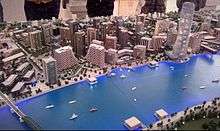Belgrade Waterfront

Belgrade Waterfront, known in Serbian as Belgrade on Water (Serbian: Београд на води / Beograd na vodi), is a catalytic development project headed by the Government of Serbia aimed at improving Belgrade's cityscape and economy by revitalizing the Sava amphitheater, a neglected stretch of land on the right bank of the Sava river, between the Belgrade Fair and Belgrade Main railway station. It was started in 2014 with the reconstruction of the Belgrade Cooperative building, which was finished in June of the same year.
It was announced on 15 March 2015 that the Phase I apartments in BW Residences, a premium riverside residential development, will be launched for sale. These two towers will each have around 20 floors, consisting of 296 apartment units, and construction started in October 2015.[1]
Overview
The project was initiated in 2014 between the Serbian government and Eagle Hills, a leading Abu Dhabi-based private investment and development company that is focused on the creation of new city hubs in high-growth international markets. Around €3.5 billion will be invested by the Serbian government and their Emirati partners.[2] The project includes office and luxury apartment buildings, Belgrade Park, Sava Promenada, five-star hotels, Belgrade Mall and Belgrade Tower, which will be the home to Serbia's first St Regis Hotel & St Regis Residences. Standing at close to 210 metres, this iconic building is designed by the world-renowned architectural firm, Skidmore, Owings & Merrill.[3]
Critique
Among Belgrade residents, there is a great deal of contempt for the project. The points criticised encompass the lacking of a public consultation process as well as the obvious disconnect of the lifestyle of Belgrade's middle and upper classes on one hand and the target group of the developed apartments on the other hand.[4] In addition to this, the intransparency and perceived backroom nature of the Belgrade Waterfront deal has caused real anger, expressed most visibly by the street protests organised by the movement Ne da(vi)mo Beograd (loosely translated: “We won’t let Belgrade d(r)own”).[5]
In May 2016, thousands of people went on the street to protest against an incident where dozens of men with masks demolished buildings in the area, where the Belgrade Waterfront complex is planned to be built.[6] Contrasting the allegations of the protesters, the government denies any responsibility in and knowledge of the event.[7][8]
First phase
- BW Residences Two 20-storey residential towers located on Sava river bank. Construction had started in October 2015 and is expected to complete by early 2018.
- W Hotel Belgrade Hotel and residences. Location is the next to BW Residences.
- Belgrade Mall will have around 300,000 square meters.
- Belgrade Tower will be located between Mall and BW Residences. Height will be 168m. Chicago based Skidmore, Owings & Merrill is the tower architect designer.[9] Tower will be residential, office and St. Regis hotel.
- BW Block 18 Two 23-storey residential and commercial towers located on Sava river
bank.Construction will start October 2016.
- BW Mall Towers Near the Mall BG planned 3 towers residential and commercial towers
a height of 80 meters.
- BW Vista Tower will be residential and commercial a height of 84 meters.Construction had started in November 2016.
See also
- Architectural projects under construction in Belgrade
- Belgrade Metro
- Serbia–United Arab Emirates relations
- Belgrade Tower
References
- ↑ "Beograd na vodi" na predstavljanju u Kanu Aktuelno.net 2015-03-10
- ↑ "Ovako će izgledati "Beograd na vodi"". Blic.rs. 2014-01-19.
- ↑ UAE firm to develop Belgrade Waterfront project, (Agencies) / 28 June 2014
- ↑ "Belgrade's 'top-down' gentrification is far worse than any cereal cafe". The Guardian. 10 December 2015. Retrieved 19 July 2016.
- ↑ "Belgrade Waterfront: an unlikely place for Gulf petrodollars to settle". The Guardian. 10 December 2015. Retrieved 19 July 2016.
- ↑ Serbian Protesters Say Authorities Were Behind Demolitions http://www.balkaninsight.com/en/article/thousands-serbians-protest-accusing-authorities-for-masked-demolition-05-12-2016#sthash.t0pQrcqF.dpuf
- ↑ "Serbian Protesters Say Authorities Were Behind Demolitions". BalkanInsight. 12 May 2016. Retrieved 19 July 2016.
- ↑ "Belgrade mayor "won't resign over 50 people protesting"". B 92. 18 July 2016. Retrieved 19 July 2016.
- ↑